Shifting Perspectives
CHEQUITA NAHAR
Recipient of the Françoise van den Bosch award 2022
Interesting things are happening in the field of jewellery and adornment worldwide, with a new generation of makers that connect their artistic practice to their cultural background or heritage. From makers with a bicultural background, third culture kids who mix cultures and together form a global fashion and jewellery scene with similar values experiences and styles, to Indigenous artists that reclaim their culture and mix traditions with contemporary pop culture and urban aesthetics. This diverse group of creators from virtually all parts of the world share an awareness of the negative destructive influence that colonialism has had and still has on their cultures and heritage, and a need to reclaim tradition and heritage and make them part of t heir lives and experiences now, at this moment in time.
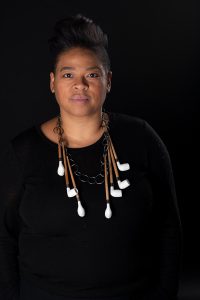
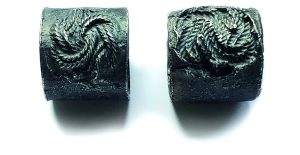
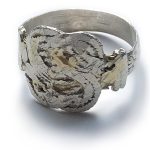
CHEQUITA NAHAR
This new generation is standing on the shoulders of makers that have been raising awareness for the last decades, opening up the jewellery field to new voices and perspectives. This brings us to Chequita Nahar ( 1970) jewellery designer, tutor and curator, and recipient of the Françoise van den Bosch award 2022. Nahar has steadily been developing a body of work and a cultural practice that is informed by her bicultural background having lived in Suriname and the Netherlands and reflects on a fusion of influences.
Through her work Nahar touches on contemporary and social topics concerning histories that have long been ignored. The Netherlands ’relationship with its former colony Suriname has been contested, and the discussion about the consequences of Dutch colonization on the Surinamese diaspora has only recently be gun Nahar, however, never gets explicitly political, she exercises soft power through her social practice.
As a maker she combines Afro Surinamese crafts and techniques with methods that are rooted in contemporary jewellery practices. In it, she discusses Afro Surinamese culture, its rituals, symbolism and visual language which she connects to her experience of Dutch culture.
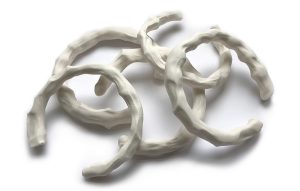
PEMBA
A good example are the bracelets Pemba. Pemba (also known as pimba doti is a white clay that is used in Surinamese Winti rituals for covering amulets and other objects related to magic, and for decorating the human body. Worn so close to the body, its use is intimate on both a physical and spiritual level. Winti is an Afro Surinamese religion that is based on beliefs and practices of enslaved people brought to Suriname from West Africa and was forbidden by law until as late as 1971, which made the use of ritual materials such as pemba subversive and potentially dangerous.
Pemba is also known as kaolin or China clay, a common industrial mineral known as pipe clay in the Netherlands which became essential for the manufacturing of pipes in the 17 th and 18 th century, an important industry that grew under influence of the popularity of tobacco, a colonial crop and commodity produc ed in Dutch colonies such as Suriname. Pemba or kaolin, the history of this material reflects or confronts the intertwined colonial histories of both Suriname and the Netherlands.
Nahar’s subtle use of the material, the intimate traces of her hands visible in the clay, can make one ignore the harsh realities of colonialism. Yet, for those interested, Nahar’s work connects these histories and challenges our Eurocentric gaze.
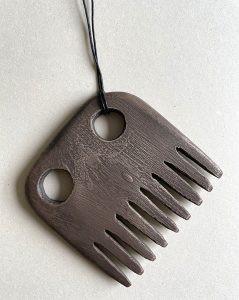
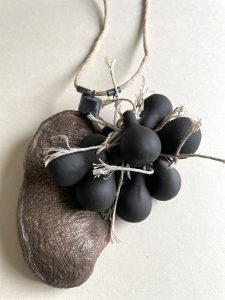
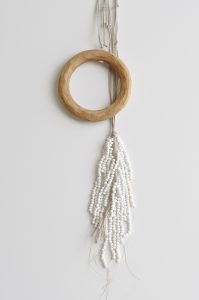
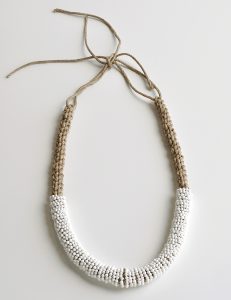
BOUNDARIES
Recent discussions about decolonization have created a careful shift in thinking about the strict boundaries in the jewellery field, one that runs parallel to wider social discussions about diversity, equity and inclusion. Breaking or setting these boundaries includes identifying and redefining shared terms and definitions.
Terms identifying the jewellery discipline have always been contested, often used interchangeably on axes in time and space: Studio Jewellery, Author Jewellery, Art Jewellery, Contemporary Jewellery, to name a few. However, an understanding of what the discipline encompasses has always been clear: a shared system of values and concepts about making, wearing and giving meaning to jewellery connected to an infrastructure that includes art academies, galleries, collectors, thinkers and museums.
At least, clear for those active in the field; ‘outsiders’ often wonder about the strict boundaries within the discipline, about what contemporary jewellery is and is not. Disciplinary boundaries are valuable on many levels but should always be questioned for it touches upon ownership: who and what is included – and excluded – and why? And who sets these boundaries? Strict boundaries on many levels in the jewellery field have systematically excluded and ignored artists of colour and ‘non-Western’ artists which has resulted in underrepresentation.

SHIFTING PERSPECTIVES
Chequita Nahar’s practice is representative of a shift in perspective. It questions ownership, dominant aesthetics and narratives in a field in which Eurocentrism has been causing exclusion of many forms of expression and aesthetics.
It has made her a significant voice in the contemporary jewellery field; through her engagement in the field as a passionate educator (Head of programme Fine Art and Design, Maastricht Institute of Arts) and curator (Schmuck, 2020). She has been an important promoter of diversity, equity and inclusion in art education, fuelling a – sometimes difficult – discussion in the jewellery field whilst making sure everyone is included, bringing people together on a topic that often triggers polarization. Her commitment to opening up the field to polyphonic narratives and perspectives and in broadening its scope cannot be underestimated, neither should her role as instigator of discussions about diversity, equity and inclusion.
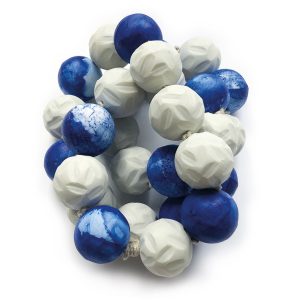
FRANÇOISE VAN DEN BOSCH AWARD 2022
The Françoise van den Bosch award is one of the most important international awards in the field of jewellery design. It is awarded once every two years to a jewellery designer, in the Netherlands or abroad, as a recognition of their oeuvre. The Françoise van den Bosch Prize is not a competition.
In their work, the award winners contribute to the development of the field, break new ground or know how to put contemporary jewellery in a new light. Their work, attitude and approach is an example for a younger generation of makers. The prize is awarded on the recommendation of an independent jury.
The jury for the Françoise van den Bosch award 2022 consisted of Lauren Kalman, Amanda Pinatih, Anneleen Swillens, Frank Verkade and Evert Nijland and was chaired by the author.
Awarding Chequita Nahar the Françoise van den Bosch award is not solely a way to applaud and stimulate her manifold practice. The jury wants to stimulate her artistic practice and educational endeavours, and make sure her voice reaches a wide audience. The jury values Chequita Nahar’s commitment to the craft of jewellery design in all its aspects, as a maker and educator. Lastly, the jury believes it important that a black female voice is brought into the series of winners of the Françoise van den Bosch Award, thereby questioning the role of this award and the representative function of the foundation.
ABOUT THE AUTHOR
Vanessa de Gruijter is chair of the Françoise van den Bosch Foundation and curator in the broad field of design.
Photo C. Nahar: Michiel Heffels



